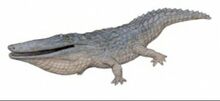(Adding categories) Tag: categoryselect |
mNo edit summary Tags: Visual edit apiedit |
||
| Line 1: | Line 1: | ||
| − | '''''Mourasuchus''''' is an extinct genus of giant crocodilian from the Miocene of South America. The skull has been described as duck like, being broad, flat and very elongate, closely resembling what is seen in ''Stomatosuchus'', an unrelated crocodilian that may also have had a large gular sac similar to those of pelicans or baleen whales. ''Mourasuchus'' had rows of small, conical teeth numbering around 40 on each side of the upper and lower jaws. ''Mourasuchus'' presumably obtained its food by filter feeding; the jaws were too gracile for the animal to have captured larger prey. It also probed the bottoms of lakes and rivers for food. Fossils have been found in the Fitzcarrald Arch of Peru, where it coexisted with many other crocodilians, including the giant gharial, ''Gryposuchus'', and the caiman ''[[Purussaurus]]'', both of which were 12 m. The great diversity of crocodylomorphsin this Miocene-age (Tortonian stage, 8 million years ago) wetland suggests that niche partitioning was efficient, which would have limited interspecific competition. |
+ | [[File:IMG 20170616 145826.jpg|thumb|220x220px|Artist's illustration of Mourasuchus amazonensis]]'''''Mourasuchus''''' is an extinct genus of giant crocodilian from the Miocene of South America. The skull has been described as duck like, being broad, flat and very elongate, closely resembling what is seen in ''Stomatosuchus'', an unrelated crocodilian that may also have had a large gular sac similar to those of pelicans or baleen whales. ''Mourasuchus'' had rows of small, conical teeth numbering around 40 on each side of the upper and lower jaws. ''Mourasuchus'' presumably obtained its food by filter feeding; the jaws were too gracile for the animal to have captured larger prey. It also probed the bottoms of lakes and rivers for food. Fossils have been found in the Fitzcarrald Arch of Peru, where it coexisted with many other crocodilians, including the giant gharial, ''Gryposuchus'', and the caiman ''[[Purussaurus]]'', both of which were 12 m. The great diversity of crocodylomorphsin this Miocene-age (Tortonian stage, 8 million years ago) wetland suggests that niche partitioning was efficient, which would have limited interspecific competition. |
| − | [[File:IMG 20170616 145826.jpg|thumb|220x220px|Artist's illustration of Mourasuchus amazonensis]] |
||
| − | |||
== Species == |
== Species == |
||
The type species of ''Mourasuchus'' is ''M. amazonensis'', named in 1964. Another species, ''M. atopus'', was named after having been initially assigned to its own genus, ''Nettosuchus'', a year later in 1965. The latter species has a longer and narrower skull than the type species. A third species, ''N. nativus'', was named in 1985, but it was considered a junior synonym of M. arendsi by Scheyer & Delfino (2016). A fourth species, ''M. pattersoni'', was described by Cidade et al. (2017). |
The type species of ''Mourasuchus'' is ''M. amazonensis'', named in 1964. Another species, ''M. atopus'', was named after having been initially assigned to its own genus, ''Nettosuchus'', a year later in 1965. The latter species has a longer and narrower skull than the type species. A third species, ''N. nativus'', was named in 1985, but it was considered a junior synonym of M. arendsi by Scheyer & Delfino (2016). A fourth species, ''M. pattersoni'', was described by Cidade et al. (2017). |
||
Revision as of 17:46, 16 June 2017

Artist's illustration of Mourasuchus amazonensis
Mourasuchus is an extinct genus of giant crocodilian from the Miocene of South America. The skull has been described as duck like, being broad, flat and very elongate, closely resembling what is seen in Stomatosuchus, an unrelated crocodilian that may also have had a large gular sac similar to those of pelicans or baleen whales. Mourasuchus had rows of small, conical teeth numbering around 40 on each side of the upper and lower jaws. Mourasuchus presumably obtained its food by filter feeding; the jaws were too gracile for the animal to have captured larger prey. It also probed the bottoms of lakes and rivers for food. Fossils have been found in the Fitzcarrald Arch of Peru, where it coexisted with many other crocodilians, including the giant gharial, Gryposuchus, and the caiman Purussaurus, both of which were 12 m. The great diversity of crocodylomorphsin this Miocene-age (Tortonian stage, 8 million years ago) wetland suggests that niche partitioning was efficient, which would have limited interspecific competition.
Species
The type species of Mourasuchus is M. amazonensis, named in 1964. Another species, M. atopus, was named after having been initially assigned to its own genus, Nettosuchus, a year later in 1965. The latter species has a longer and narrower skull than the type species. A third species, N. nativus, was named in 1985, but it was considered a junior synonym of M. arendsi by Scheyer & Delfino (2016). A fourth species, M. pattersoni, was described by Cidade et al. (2017).